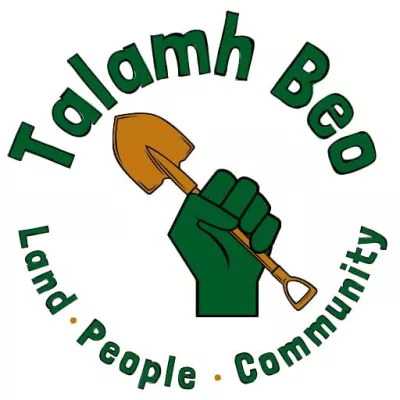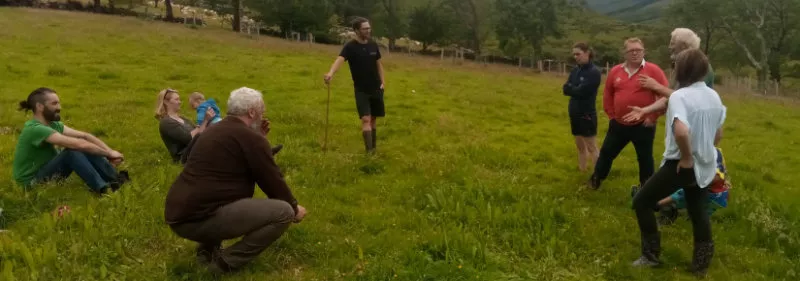General information
RDP Priority
- P4. Ecosystems management
RDP Focus Area
- 4A: Biodiversity restoration, preservation & enhancement
RDP Measure
- M16: Cooperation
Beneficiary type
- Operational group
Summary
The Soil Biodiversity Literacy and Enhancement Project was managed by Talamh Beo, the agroecological farmers representative organisation in Ireland. The overall aim was to address the need for regenerating soil health and to improve the biodiversity and nutrient quality of soils - leading to enhanced climate resilience and an improved quality of food production. The project involved 16 participating farmers assessing their relevant needs, designing, leading and implementing the project. Each farmer took an active role in building a better understanding of soil complexity – particularly regarding soil biodiversity.
The aim was to create a new set of traditions and practices around soil improvement based on innovative as well as tried and tested agroecological methods.
A participative approach was utilised for project implementation. The project activities involved the farmers directly in designing modern analytical methods aimed at improving and augmenting the health of their soils.
Results
- The project resulted in a large number of climate and environmental benefits, including enhanced nutrient cycling, carbon sequestration, reduced soil erosion, improved water retention, biodiversity support, natural pest control, resilient ecosystems, healthier watersheds, enhanced habitat, reduced GHGs, improved soil structure, richer nutrient content, vibrant microbial activity, sustainable land management, increased plant resilience, biodiverse landscapes, support for pollinators.
- Sixteen farmers acquired in-depth knowledge of soil structure, health and biodiversity, and acquired skills to remediate and regenerate soils. Results created new income generation potential from soil improvements allowing diversification.
- A legacy of 16 lighthouse farms contributing to climate mitigation, adaptation and reducing GHG emissions.
- A network of farmers in Talamh Beo’s Soil Group who offer each other peer-to-peer learning, sharing of experience and support to help themselves help each other.
- All genders had equal access to designing, leading, implementing and benefiting from this project.

Promoter
Talamh Beo CLG*
* The project promoter/beneficiary is an EIP-AGRI Operational Group (https://ec.europa.eu/eip/agriculture/en)
Funding
RDP support: 215 775 (EUR)
Resources
Context
The increasing use of artificial chemical fertilisers, sprays and heavy machinery over the last 50 years has had a negative effect on soil ecology, biodiversity and, in many cases, the health of wider ecosystems, in particular watercourses. The agricultural sector’s current dependence on such inputs with high economic and climatic costs, as well as negative impacts on soil biodiversity, is not sustainable.
Whilst most soils contain more than sufficient nutrients for healthy plant growth, they are often in forms that are largely inaccessible to plants. In contrast, soils with increased biological diversity are more capable of facilitating biological processes that can break down less accessible nutrients and make them more easily available to plants. Such soils are also more resilient to shocks, such as water saturation or drought, and have been shown to produce plants with a more complex nutrient density than soils treated with conventional fertilisers.
Talamh Beo, the agroecological farmers representative organisation in Ireland led the Soil Biodiversity Literacy and Enhancement Project. The organisation believes that farmers and communities should be at the centre of decision-making for food and agriculture systems and developing agricultural policies. This Operational Group project was established to build an understanding of the methods and options available to farmers for enhancing soil biodiversity. By regenerating the soil, the quality of the food these soils produce will also improve. The aboveground biodiversity is inextricably linked to the diversity of our soils, thus starting with the soil is truly starting from the bottom up.
Objectives
The key objectives of the project were to:
- Increase farmers’ agroecology knowledge and skills to improve and enhance soil biodiversity by empowering farmers to remediate their soils to deliver long-term sustainability.
- Tackle biodiversity loss starting with restoring soil biodiversity and soil health in order to sequester carbon, mitigate climate change and reduce erosion and nutrient runoff, subsequently protecting the environment.
- Increase peer-to-peer knowledge and skills exchange amongst farmers. This included upskilling farmers, adding citizen science, and experimenting and testing innovations for their role of producing food, fuel and fibre. The key ambition was that a new generation of farmers would emerge from the changed context.
- Establish ‘lighthouse farms’ so farmers become beacons of sustainable soil management for nationwide and EU-wide replication.
Activities
The activities of the Talamh Beo Soil Biodiversity Literacy and Enhancement project were implemented by 16 participating farms across Ireland throughout a complete growing season, from early winter 2021 to early winter 2022. The activities included:
- The educational component of an online Soil Food Web (SFW) Foundation and Microscopy Course that was provided by leaders in the field. This course in winter 2021 allowed its learning to be applied on test plots on each farm over the following spring and summer months. The plots tested as part of this initiative, identified and mapped by participating farmers, covered a range of ecosystems and soil types and conditions over several land use practices (horticulture, tillage, pasture grazing, woodland or agroforestry etc.) and in different water catchment areas.
- This EIP-AGRI project establishing a baseline for assessing the results of the innovations trialled by participants. These participants took chemical and biological soil samples on each of the plots and conducted physical tests (to examine below and aboveground biodiversity and conditions). This data was recorded and uploaded to the participants’ profiles on the Talamh Beo website.
- Technical innovations, including micro biometers and spectrometers, and physical innovations (e.g. soil biological activators, mineral amendments, biochar, green manure, compost, compost teas, inoculants etc) being trialled and documented by farmers during the growing season as part of this project.
- The participants discussing their experiences and sharing information in a series of ten knowledge transfer group meetings. These also facilitated planning and decision making between the participants.
- Each participating farm hosting a farm walk or event over the summer months to share the project with the greater public or to deepen the discussion between the participants.
- A hub of expertise and resources, including a soil scientist and a farm advisor was made available to the participating farms and was brokered in and out as needed.
- This EIP-AGRI project connecting with several stakeholders and multipliers with the aim of connecting the citizen to the living soil and the relevant scientific knowledge. It is envisaged going forward that the lighthouse farms will use their acquired skills and knowledge to provide an agroecology resource for local county councils, local environmental networks, schools and colleges, among others, as they engage with understanding and responding to the climate and biodiversity crisis.
Main results
- The project resulted in a large number of climate and environmental benefits, including enhanced nutrient cycling, carbon sequestration, reduced soil erosion, improved water retention, biodiversity support, natural pest control, resilient ecosystems, healthier watersheds, enhanced habitat, reduced GHGs, improved soil structure, richer nutrient content, vibrant microbial activity, sustainable land management, increased plant resilience, biodiverse landscapes, support for pollinators.
- 16 farms have an increased potential for income generation through diversification as a consequence of the improved soil.
- 16 farmers acquired an in-depth knowledge of soil structure, health and biodiversity, and acquired agroecology skills to remediate and regenerate soils.
- 16 active experiments contributing to climate mitigation, adaptation and reducing GHG emissions (e.g. inoculated biochar, balancing fungi-to-bacteria ratios, increasing pH in soils through biological activity) and strengthening environmental protection (e.g. flocculating heavy soils mechanically and biologically).
- A legacy of 16 lighthouse farms with microscopy and laboratory skills.
- A network of farmers in Talamh Beo’s Soil Group who offer each other peer-to-peer learning, sharing and support.
- In terms of societal benefits, this EIP-AGRI project fostered cooperation capacity, whereby farmers learned to help themselves and each other by taking action. The principles of peer-to-peer learning delivered on sustainability aspects.
- Overall, the project applied a gender equality approach, whereby all genders had equal access to designing, leading, implementing, and benefiting from the project.
Key lessons
- Three aspects underpinned the success of the project, including agroecology’s all-inclusive science-led and farmer-oriented principles, the insights of farmers and participatory methods. These three are essential starting points for any future project.
- The peer-to-peer component of the project forged strong bonds between the participating farmers. They collaborated, supported and inspired each other, creating a network of shared experiences and mutual empowerment.
- Peer-to-peer learning also spurred and accelerated innovation. The farmers experimented with novel techniques, refining and adapting them to their local conditions. This grassroots innovation process enhanced the effectiveness and sustainability of soil regeneration practices.
- Participatory approaches empower local communities to become stakeholders in shaping development projects that affect their lives, fostering a sense of ownership and accountability.
- A bottom-up approach encourages knowledge exchange, collaboration and collective innovation. Farmers share insights and experiences, while researchers provide scientific expertise, resulting in comprehensive solutions.
“Learning about the soil allows me to better manage and care for it. Understanding the world below our feet allows us to farm in a more sustainable and environmentally conscious way.”
“Farmers are used to being confronted with problems and opportunities. They come up with solutions or approaches based on what they have to hand and what they need to access. They either broker in the latter, learn it, or a combination of both – they learn by watching someone they brought in to help them. This is a unique and valuable skill, and EIP’s and similar projects working with such rural stakeholders should recognise and use it. Allow farmers to take the lead in projects, use them for certain components. Acknowledge their contribution has value like any other service provider and pay them for the work they do. You will be surprised how much farmers know, and how willing they are to learn what they don’t know.”
